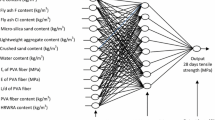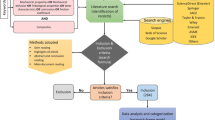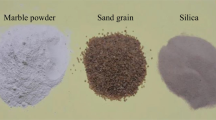Abstract
In this paper, a nonlinear formulation approach using an artificial neural network (ANN) is proposed and applied for the first time to predict the behavior of rubberized cement composite for which there is neither a design formulation nor a closed-form prediction model. For this purpose, the experimental data on the rubberized composite was collected, which includes mix ingredients, curing condition, and age. The statistical analysis of the data was performed to well characterize the interdependencies. Then, the ANN model was built, and the parameters for the optimum ANN model were found. Afterward, based on the relationships used in the ANN architecture at different steps, such as inputs nodes, neurons of hidden layers, activation functions, and output calculations, the ANN model was formulated, and the optimum weights and biases were determined. Once the closed-form formulation was derived, of the model’s performance was assessed through its prediction correlation and error. It was found that the ANN formulation was very robust to predict the complex behavior of rubberized composites with R2 = 0.98. Finally, the normalized importance of the model’s inputs was determined and the parametric study of the ANN model was also performed to show the effect of each variable on the output. The results showed that the relationships between the inputs and the output were mostly nonlinear, indicating the fact that the system’s behavior is a complex problem, which was well captured by formulation-based ANN model.
















Similar content being viewed by others
Explore related subjects
Discover the latest articles and news from researchers in related subjects, suggested using machine learning.Change history
02 November 2022
This article has been retracted. Please see the Retraction Notice for more detail: https://doi.org/10.1007/s00366-022-01755-x
References
Jalal M, Moradi-Dastjerdi R, Bidram M (2019) Big data in nanocomposites: ONN approach and mesh-free method for functionally graded carbon nanotube-reinforced composites. J Comput Des Eng 6(2):209–223. https://doi.org/10.1016/j.jcde.2018.05.003
Mortazavi AA, Jalal M (2014) Investigation of CFRP-and GFRP-confined concrete cylinders under monotonic and cyclic loading. Sci Eng Compos Mater 21(4):607–614. https://doi.org/10.1515/secm-2013-0213
Saeidi Marzangoo HR, Jalal M (2014) A semi-analytical three-dimensional free vibration analysis of functionally graded curved panels integrated with piezoelectric layers. Sci Eng Compos Mater 21(4):571–587. https://doi.org/10.1515/secm-2013-0225
Vazinram F, Jalal M, Foroushani MY (2015) Effect of nano ZnO2 and lime water curing on strength and water absorption of concrete. Int J Mater Prod Technol 50:356–365. https://doi.org/10.1504/IJMPT.2015.068556
Jalal M, Mansouri E (2013) Thermal and mechanical characteristics of cement nanocomposites. Sci Eng Compos Mater 20(1):35–40. https://doi.org/10.1515/secm-2012-0053
Jodaei A, Jalal M, Yas MH (2012) Free vibration analysis of functionally graded annular plates by state-space based differential quadrature method and comparative modeling by ANN. Compos Part B Eng 43(2):340–353. https://doi.org/10.1016/j.compositesb.2011.08.052
Jodaei A, Jalal M, Yas MH (2013) Three-dimensional free vibration analysis of functionally graded piezoelectric annular plates via SSDQM and comparative modeling by ANN. Math Comput Model 57(5):1408–1425. https://doi.org/10.1016/j.mcm.2012.12.002
Garmsiri K, Jalal M (2014) Multiobjective optimization of composite cylindrical shells for strength and frequency using genetic algorithm and neural networks. Sci Eng Compos Mater 21(4):529–536. https://doi.org/10.1515/secm-2013-0208
Jalal M, Nassir N, Jalal H (2019) Waste tire rubber and pozzolans in concrete: a trade-off between cleaner production and mechanical properties in a greener concrete. J Clean Prod. https://doi.org/10.1016/j.jclepro.2019.117882
Jalal M, Nassir N, Jalal H, Arabali P (2019) On the strength and pulse velocity of rubberized concrete containing silica fume and zeolite: prediction using multivariable regression models. Constr Build Mater 223:530–543. https://doi.org/10.1016/j.conbuildmat.2019.06.233
Sotoudeh MH, Jalal M (2013) Effects of waste steel fibers on strength and stress–strain behavior of concrete incorporating silica nanopowder. Indian J Sci Technol 6(10):5411–5417
Jalal M (2013) Influence of class F fly ash and silica nano-micro powder on water permeability and thermal properties of high performance cementitious composites. Sci Eng Compos Mater 20(1):41–46. https://doi.org/10.1515/secm-2012-0054
Jalal M (2012) Transport properties of high-performance cementitious composites incorporating micro and nano SiO2 into the binder. Sci Eng Compos Mater 19(4):415–421. https://doi.org/10.1515/secm-2012-0056
Mukhopadhyay AK, Liu KW, Jalal M (2019) An innovative approach to fly ash characterization and evaluation to prevent alkali–silica reaction. ACI Mater J 116(4):173–181. https://doi.org/10.14359/51716751
Arabali P, Shekarchi M (2015) Durability of jointed reinforced concrete pavements under sever exposure conditions: a case study in Iran. In: XIII international conference on durability of building materials and components, pp 866–873
Raffoul S, Garcia R, Pilakoutas K, Guadagnini M, Medina NF (2016) Optimisation of rubberised concrete with high rubber content: an experimental investigation. Constr Build Mater 124:391–404. https://doi.org/10.1016/j.conbuildmat.2016.07.054
Pelisser F, Ni Zavarise, Longo TA, Bernardin AM (2011) Concrete made with recycled tire rubber: effect of alkaline activation and silica fume addition. J Clean Prod 19:757–763. https://doi.org/10.1016/j.jclepro.2010.11.014
Elchalakani M (2015) High strength rubberized concrete containing silica fume for the construction of sustainable road side barriers. Structures 1:20–38. https://doi.org/10.1016/j.istruc.2014.06.001
Youssf O, Mills JE, Hassanli R (2016) Assessment of the mechanical performance of crumb rubber concrete. Constr Build Mater 125:175–183. https://doi.org/10.1016/j.conbuildmat.2016.08.040
Yang F, Feng W, Liu F, Jing L, Yuan B, Chen D (2019) Experimental and numerical study of rubber concrete slabs with steel reinforcement under close-in blast loading. Constr Build Mater 198:23–436. https://doi.org/10.1016/j.conbuildmat.2018.11.248
Duarte APC, Silvestre N, de Brito J, Júlio E (2017) Numerical study of the compressive mechanical behaviour of rubberized concrete using the eXtended Finite Element Method (XFEM). Compos Struct 179:132–145. https://doi.org/10.1016/j.compstruct.2017.07.048
Rezaifar O, Hasanzadeh M, Gholhaki M (2016) Concrete made with hybrid blends of crumb rubber and metakaolin: optimization using response surface method. Constr Build Mater 123:59–68. https://doi.org/10.1016/j.conbuildmat.2016.06.047
Jalal M, Grasley Z, Gurganus C, Bullard JW (2020) Experimental investigation and comparative machine-learning prediction of strength behavior of optimized recycled rubber concrete. Constr Build Mater. https://doi.org/10.1016/j.conbuildmat.2020.119478
Jalal M, Teimortashlu E, Grasley Z (2019) Performance-based design and optimization of rheological and strength properties of self-compacting cement composite incorporating micro/nano admixtures. Compos Part B Eng 163:497–510. https://doi.org/10.1016/j.compositesb.2019.01.028
Teimortashlu E, Dehestani M, Jalal M (2018) Application of Taguchi method for compressive strength optimization of tertiary blended self-compacting mortar. Constr Build Mater 190:1182–1191. https://doi.org/10.1016/j.conbuildmat.2018.09.165
Jalal M, Mirsayar M, Mukhopadhyay AK (2019) A novel multiscale modeling approach for evaluation of the ASR in concrete structures. In: Sixth international conference on durability of concrete structures (ICDCS2018). University of Leeds, pp 844–850
Cevik A (2007) Unified formulation for web crippling strength of cold-formed steel sheeting using stepwise regression. J Constr Steel Res 63:1305–1316. https://doi.org/10.1016/j.jcsr.2007.01.001
Jalal M, Goharzay M (2019) Cuckoo search algorithm for applied structural and design optimization: float system for experimental setups. J Comput Des Eng 6(2):159–172. https://doi.org/10.1016/j.jcde.2018.07.001
Jalal M, Mukhopadhyay AK, Grasley Z (2019) Design, manufacturing, and structural optimization of a composite float using particle swarm optimization and genetic algorithm. Proc Inst Mech Eng Part L J Mater Des Appl 233(7):1404–1418. https://doi.org/10.1177/1464420718755546
Goharzay M, Noorzad A, Mahboubi Ardakani A, Jalal M (2017) A worldwide SPT-based soil liquefaction triggering analysis utilizing gene expression programming and bayesian probabilistic method. J Rock Mech Geotech Eng 9(4):683–693. https://doi.org/10.1016/j.jrmge.2017.03.011
Goharzay M, Noorzad A, Mahboubi Ardakani A, Jalal M (2020) Computer-aided SPT-based reliability model for probability of liquefaction using hybrid PSO and GA. J Comput Des Eng 7(1):107–127. https://doi.org/10.1093/jcde/qwaa011
Jalal M, Mukhopadhyay AK, Goharzay M (2019) Bat algorithm as a metaheuristic optimization approach in materials and design: optimal design of a new float for different materials. Neural Comput Appl 31(10):6151–6161. https://doi.org/10.1007/s00521-018-3430-4
Jalal M (2015) Soft computing techniques for compressive strength prediction of concrete cylinders strengthened by CFRP composites. Sci Eng Compos Mater 22(1):97–112. https://doi.org/10.1515/secm-2013-0240
Fathi M, Jalal M, Rostami S (2015) Compressive strength prediction by ANN formulation approach for CFRP confined concrete cylinders. Earthq Struct 8(5):1171–1190. https://doi.org/10.12989/eas.2015.8.5.1171
Vakhshouri B, Nejadi S (2018) Prediction of compressive strength of self-compacting concrete by ANFIS models. Neurocomputing 280:13–22. https://doi.org/10.1016/j.neucom.2017.09.099
Jalal M, Grasley Z, Nassir N, Jalal H (2020) Strength and dynamic elasticity modulus of rubberized concrete designed with ANFIS modeling and ultrasonic technique. Constr Build Mater. https://doi.org/10.1016/j.conbuildmat.2019.117920
Jalal M, Arabali P, Grasley Z, Bullard JW (2020) Application of adaptive neuro-fuzzy inference system for strength prediction of rubberized concrete containing silica fume and zeolite. Proc Inst Mech Eng Part L J Mater Des Appl 234(3):438–451. https://doi.org/10.1177/1464420719890370
Jalal M, Ramezanianpour AA (2012) Strength enhancement modeling of concrete cylinders confined with CFRP composites using artificial neural networks. Compos Part B Eng 43(8):2990–3000. https://doi.org/10.1016/j.compositesb.2012.05.044
Jalal M, Ramezanianpour AA, Pouladkhan AR, Tedro P (2013) Application of genetic programming (GP) and ANFIS for strength enhancement modeling of CFRP-retrofitted concrete cylinders. Neural Comput Appl 23(2):455–470. https://doi.org/10.1007/s00521-012-0941-2
Ashrafi HR, Jalal M, Garmsiri K (2010) Prediction of load–displacement curve of concrete reinforced by composite fibers (steel and polymeric) using artificial neural network. Expert Syst Appl 37(12):7663–7668. https://doi.org/10.1016/j.eswa.2010.04.076
Benitez JM, Castro JL, Requena I (1997) Are artificial neural networks black boxes? IEEE Trans Neural Netw 8(5):1156–1164. https://doi.org/10.1109/72.623216
Dunlop P, Smith S (2003) Estimating key characteristics of the concrete delivery and placement process using linear regression analysis. Civ Eng Environ Syst 20:273–290. https://doi.org/10.1080/1028660031000091599
Smith GN (1986) Probability and statistics in civil engineering. Collins, London
Haykin S (2000) Neural networks—a comprehensive foundation. Macmillan College Publishing Company, New York
Guzelbey IH, Cevikb A, Erklig A (2006) Prediction of web crippling strength of cold-formed steel sheetings using neural networks. J Constr Steel Res 62:962–973. https://doi.org/10.1016/j.jcsr.2006.01.008
Liu SW, Huang JH, Sung JC, Lee CC (2002) Detection of cracks using neural networks and computational mechanics. Comput Method Appl Mech Eng 191:2831–2845. https://doi.org/10.1016/S0045-7825(02)00221-9
Rumelhart DE, Hinton GE, William RJ (1986) Learning internal representation by error propagation. In: Rumelhart DE, McClelland JL (eds) Proceeding parallel distributed processing foundation, vol 1. MIT Press, Cambridge
Anderson JA (1983) Cognitive and psychological computation with neural models. IEEE Trans Syst Man Cybern SMC 13(5):799–814. https://doi.org/10.1109/TSMC.1983.6313074
Hopfield JJ (1982) Neural networks and physical systems with emergent collective computational abilities. Proc Natl Acad Sci 79:2554–2558. https://doi.org/10.1073/pnas.79.8.2554
Suratgar AA, Tavakoli MB, Hoseinabadi A (2005) Modified Levenberg–Marquardt method for neural networks training. In Proceedings of the WEC 05: fourth world enformatika conference, Istanbul; Turkey; 24 June 2005 through 26 June 2005; Code 66493, pp 46–48
Swingler K (1996) Applying neural networks: a practical guide. Academic Press, London
Acknowledgements
The authors acknowledge and thank the Texas A&M University and the Texas A&M Transportation Institute.
Funding
No funding was received for this research project, and the authors work under Texas A&M University System.
Author information
Authors and Affiliations
Corresponding author
Ethics declarations
Conflict of interest
The authors declare that they have no conflict of interest.
Additional information
Publisher's Note
Springer Nature remains neutral with regard to jurisdictional claims in published maps and institutional affiliations.
This article has been retracted. Please see the retraction notice for more detail: https://doi.org/10.1007/s00366-022-01755-x
Appendix
Rights and permissions
Springer Nature or its licensor (e.g. a society or other partner) holds exclusive rights to this article under a publishing agreement with the author(s) or other rightsholder(s); author self-archiving of the accepted manuscript version of this article is solely governed by the terms of such publishing agreement and applicable law.
About this article
Cite this article
Jalal, M., Grasley, Z., Gurganus, C. et al. RETRACTED ARTICLE: A new nonlinear formulation-based prediction approach using artificial neural network (ANN) model for rubberized cement composite. Engineering with Computers 38, 283–300 (2022). https://doi.org/10.1007/s00366-020-01054-3
Received:
Accepted:
Published:
Issue Date:
DOI: https://doi.org/10.1007/s00366-020-01054-3




